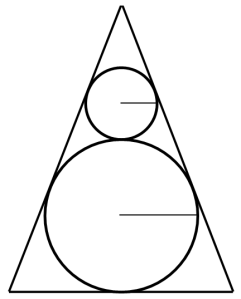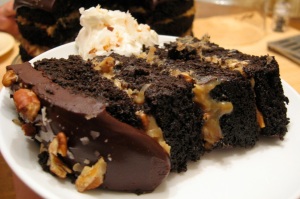Math Concepts: division as equal sharing, naming fractions, adding fractions, infinitesimals, iteration, limits
Prerequisite: able to identify fractions as part of a whole
This is how I tell the story:
- We have a cake to share, just the two of us. It’s not TOO big a cake, ‘cuz we don’t want to get sick. An 8 × 8 or 16 × 16 square on the graph paper should be just right. Can you cut the cake so we each get a fair share? Color in your part.
- How big is your piece compared to the whole, original cake?
- But you know, I’m on a diet, and I just don’t think I can eat my whole piece. Half the cake is too much for me. Is it okay if I share my piece with you? How can we divide it evenly, so we each get a fair share? How big is your new piece? Color it in.
- How much of the whole, original cake do you have now? How can you tell?
- I keep thinking of my diet, and I really don’t want all my piece of cake. It looks good, but it’s still just a bit too big for me. Will you take half of it? How big is that piece?
- Now how much of the whole, original cake do you have? How could we figure it out?
[Teaching tip: Don’t make kids do the calculation on paper. In the early stages, they can visualize and count up the fourths or maybe the eighths. As the pieces get smaller, the easiest way to find the sum is what Cohen does in the video below—identify how much of the cake is left out.]
- Even for being on a diet, I still don’t feel very hungry…
For more precalculus fun, explore Don Cohen’s Map of Calculus for Young People: hands-on activities featuring advanced ideas, for students of any age.
The Next Day
- Your best friend comes over to visit, and we share a new cake. If you, me, and the friend all get a fair share, how much of the cake do you get?
- But you know, I’m still on that diet. My piece of cake looks too big for me. I’ll share it with the two of you. Let’s cut my piece so each of us can have a share. How big are those pieces?
- How much of the whole, original cake do you have now? …
Can Young Kids Really Understand This?

We did infinite cakes in Princess Kitten’s fifth-grade year, if I remember right. Three years later, I gave my middle-school math club kids this geometry puzzle from James Tanton:
- Two circles are tangent to each other and to an isosceles triangle, as shown. The large circle has a radius of 2, and the smaller circle’s radius is 1. How tall is the triangle?
I really didn’t expect my then-8th-grade-prealgebra daughter to solve this. But I thought it might launch an interesting discussion along the lines of “What do you notice? What do you wonder?”
She stared at the diagram for a minute or two, while I bit my tongue to keep from breaking her concentration.
Then she said, “Oh, I see! It’s an infinite cake.”
It took me much longer to understand what she had seen so quickly: Imagine stacking up smaller and smaller circles in the top part of the triangle. Because all the proportions stay the same, each circle is exactly half as wide as the one below it. To find the height of the triangle, we can just add up all the diameters of the circles.
The puzzle is adapted from an AMC 10/12 Practice Quiz and is available here, with Tanton’s problem-solving tips for high school students. Tanton used similar triangles to find the height, but Princess Kitten’s infinite series approach is quicker and doesn’t require algebra.
Cake photos by Kimberly Vardeman via Flickr (CC BY 2.0): Strawberry Cream Cake and Bobby Flay German Chocolate Cake. (Text added.)



Love problems like these! So interesting that your daughter made the connection between problems so easily!
Yes, I am amazed at the ways she comes up with for solving problems. Very rarely the method I would have used, and often quite elegant.